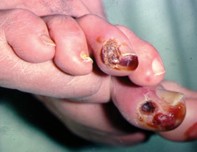Peer Reviewed
Perspectives
Prioritising assessment of ‘at-risk’ feet in diabetes: individualising foot care
Abstract
All patients with diabetes should have their feet assessed to determine their level of risk for foot complications. Foot care and education should be individualised accordingly.
Key Points
- One of the most cost-effective practices any health professional can perform in patients with diabetes is to examine their feet with their shoes removed.
- The risk of foot ulceration is doubled in patients with diabetes who also have peripheral neuropathy or peripheral arterial disease (PAD).
- Actively screening patients with diabetes for loss of protective sensation of the feet is of utmost importance as it often occurs without symptoms.
- Although peripheral neuropathy is the leading risk factor for foot ulceration, a pivotal event such as trauma from footwear will often precipitate the ulceration.
- In the assessment of PAD it is important to ask patients about symptoms of intermittent claudication or rest pain; however, those who have dense peripheral neuropathy and/or immobility are unlikely to report such symptoms.
- General foot care advice should be provided to all people with diabetes but foot care education should be tailored to the individual’s risk of complications.
Purchase the PDF version of this article
Already a subscriber? Login here.

